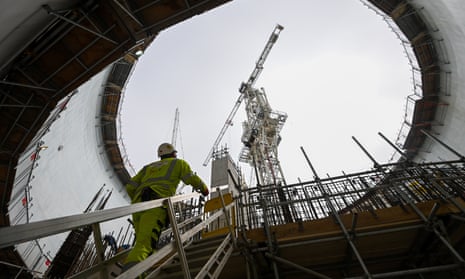Energy security secretary Grant Shapps will this week outline plans for Britain’s atomic power’s renaissance and 2050 emissions commitment
Jillian Ambrose
Sun 9 Jul 2023
Jillian Ambrose
Sun 9 Jul 2023

The construction of the traditional sized Hinkley Point C nuclear power plant in Somerset has suffered delays and is overbudget. Photograph: Finnbarr Webster/Getty Images
In London’s Science Museum sit full-size turbine engines that tell the story of 300 years of steam power. This week, the museum will play host to the government’s dreams for a new industrial renaissance – this time for nuclear energy.
The secretary of state for energy security and net zero, Grant Shapps, has chosen the venue to set out his ambitions for the UK’s nuclear programme. He is expected to illuminate the path towards the government’s existing commitment to build 24 gigawatts of nuclear power capacity – the equivalent of a quarter of Britain’s total generating capacity – by 2050.
The event, scheduled for Thursday, will also be the official launch of the arm’s-length government body that has the task of driving the delivery of new nuclear energy projects.
The first priority of Great British Nuclear (GBN) will be in streamlining the government’s ambition for small modular nuclear reactors.
These mini-reactors offer rare bright points of optimism in the government’s nuclear plans. The attempts to bring forward investment in traditionally sized reactors have yielded only the much-delayed and overbudget Hinkley Point C nuclear plant in Somerset so far.
But mini-reactors present an opportunity to harness the benefits of modular manufacturing techniques to cut the costs of full-scale construction and speed up building times. The government considers nuclear power a crucial part of its ambition to reach its 2050 net zero emissions target and its highly ambitious 2035 target to cut carbon emissions from the electricity system. A new nuclear dawn should also create highly skilled engineering and manufacturing jobs.
Each new government has given rise to new rows over the cost of supporting small modular reactors
The hope is that GBN will be able to accelerate the rollout of the mini-reactors by operating one step removed from the political wrangling of Whitehall and Westminster. In turn, mini-reactors are expected to offer a cheaper alternative to traditional nuclear power plants and be quicker to build.
It is paradoxical, then, that both plans have been heavily delayed by political upheaval in recent years. Under Boris Johnson, the government put nuclear power at the centre of its energy strategy, announced in April 2022, in response to climate concerns and a desire to ditch Russian gas.
Each new government has given rise to new rows over the cost of supporting small modular reactors. The current government hopes to announce the first competition winners in the autumn. Industry sources are hopeful that Shapps may use his forthcoming speech to clarify how the competition will progress.
Any clarification will be gladly received by executives at the jet-engines-to-nuclear-reactors company Rolls-Royce, which says that its small modular reactors could begin providing “stable, secure supplies of low-cost power” by the early 2030s.
But Rolls-Royce is not alone. In the time that it has taken for the government to launch its competition, the marketplace for small modular reactors has become a little crowded.
Hitachi has submitted a design for regulatory approval, while infrastructure group Balfour Beatty and Holtec, which manufactures components for power plants, have agreed to propose a Holtec design, with the support of Hyundai.
Rolls-Royce is understood to be sanguine about the rising competition, and comfortable in the belief that it can offer a compelling and competitive nuclear option. Still, it cannot have escaped its notice that if there had been fewer delays in the first place, it might have enjoyed more of a head start.
No comments:
Post a Comment